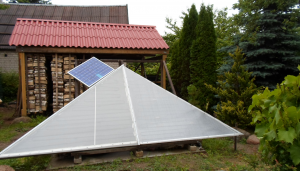Preparing for the 2019 season
(Lietuvių) 2018 metų sezonas
In 2018, the collector is filled with water and the season started on April 12th. It was sunny spring from April 1, but I still did not believe that there would be no frost.
The season ended on September 26th. There are no temperature charts, I’ve eliminated everything, and I did not get ready to sort things out. I hope next year everything will start to work properly and on time.
Started Season 2017
2017 collector filled with water and the season began on May 1st.
The season ended on October 1.
version v1.4 model
Versijos v1.23 pagrindu padarytas v1.4 maketas . Viskas sumontuota ABS plastiko modulinėje dėžutėje montuojamoje ant DIN bėgelio (53.3×90.2×57.5 mm).
Versijos v1.4 maketas (dar bus aprašymas tikslinamas)
2015 metų sezonas baigtas
2015 spalio 8 dienos vakare iš sistemos buvo išleistas vanduo. Saulės mažėja, naktimis neigiama temperatūra. Jau reikia šildyti namus, taigi naudos iš kolektoriaus nebedaug. Sezonas buvo labai ilgas.
The new version v1.23 of the solar collector controller
Made 10 pieces controller PCB. Description
underground piping test
Investigation of heat transfer losses
How one should not make a solar collector
I start the 2015 season by enlarging the solar collector’s area from 2m2 to 4m2. Roof slopes of my house are situated to the East and to the West. The initial plan was to raise the solar collector in such a way that it would be situated to the South.

One section of the collector (2m2) has been heating water for 3 seasons. The collector was situated at 120 centimeters distance from the wall. In order to situate it at 45° angle I would have had to move it at 160 cm distance from the wall. And if I wanted the 30 cm. of protruding roof not to cast a shade upon the collector too early, I would need to move the collector even at 190 cm. distance from the wall… This would mean complex holding construction. Having evaluated future troubles with servicing, I chose the simplest way and put the collector on the ground. There is a 22 meter pipe distance from the collector to the boiler. A solar panel charges 12V 7Ah battery. The system has a 12V pump, which has worked fine for 3 seasons. The collector now looks as follows:

The frame holding the collector is quadrangular, as I will have to remake it when I have a chance. After 3 seasons polycarbonate covering turned a bit yellow, even though the collector itself is holding well. Aluminum pipe connections are watertight. On a sunny day, when I blocked the end of lower pipe and filled the heat exchanger piping with water, all the water in the heat exchange reached the boiling point and evaporated.





